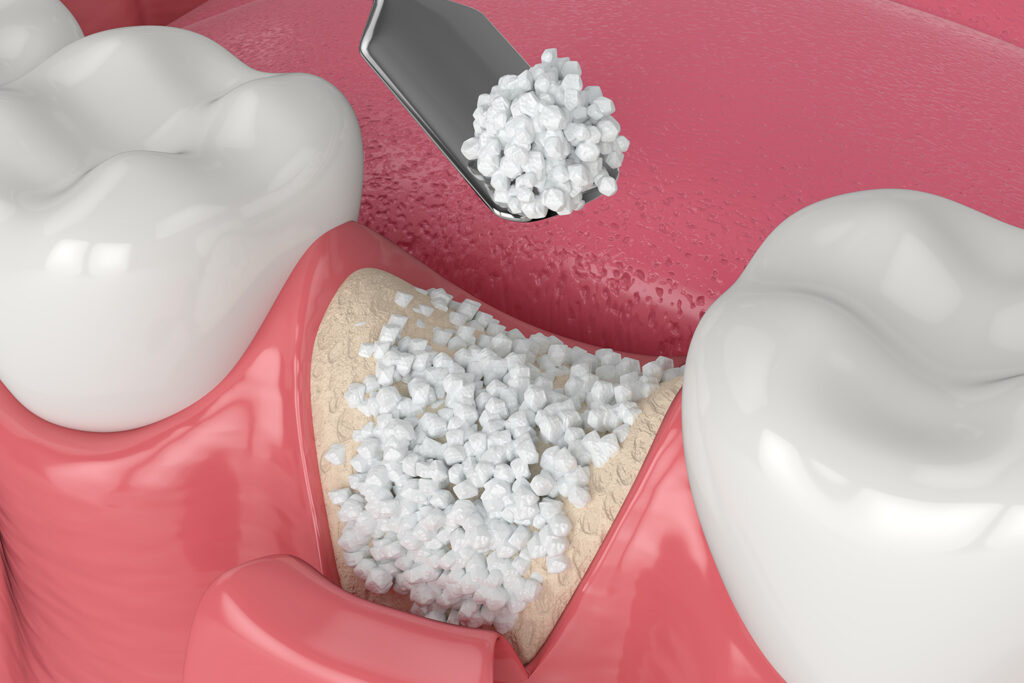As we age, our bodies change, and our teeth are no exception. Tooth decay, gum disease, or trauma can cause tooth loss, which can be frustrating, uncomfortable, and affect your confidence. Dental implants are an effective, long-lasting solution for missing teeth, but not everyone is a candidate for this treatment. In cases where there isn’t enough bone to support the implant, a dental bone graft may be necessary.
A dental bone graft is a surgical procedure that involves adding bone material to your jaw to create a stable base for the implant. This procedure is becoming increasingly common and has a high success rate. In this blog, we’ll discuss why you might need a dental bone graft, what the procedure involves, and how it can benefit you. We’ll also address common concerns and misconceptions about the procedure and provide tips on how to prepare for it and promote healing after the surgery.
Whether you’re considering dental implants or have already decided to proceed with the treatment, it’s essential to understand the importance of dental bone grafting and how it can improve your oral health and overall well-being.

Why Would You Need A Dental Bone Graft?
There are several reasons why you might need a dental bone graft, including bone loss from periodontal disease or trauma, and the procedure can help improve the success rate of dental implants in these situations.
If you have experienced tooth loss, your jawbone may have deteriorated or become too thin to support a dental implant, which can result in implant failure. Bone loss can be due to a variety of factors, including gum disease, tooth decay, and trauma. A dental bone graft can help restore the bone density in your jaw, creating a stable foundation for the implant and improving the success rate of the implant. In addition, bone grafting can also help improve the appearance of your jawline and enhance your facial features.
In some cases, bone loss is so severe that a bone graft may not be sufficient, and your dentist may recommend additional procedures or alternative solutions, such as mini dental implants, implant-supported bridges, or dentures. The best way to determine whether you need a bone graft is to schedule a consultation with your dentist, who can assess your oral health and recommend the most appropriate treatment plan for your needs.
How is a Dental Bone Graft Performed?
Here’s a step-by-step guide to help you understand the process.
- Consultation and Preparation: Before the procedure, your dentist will conduct a thorough oral examination and take X-rays or CT scans to assess the bone density and determine the appropriate grafting material. You’ll also discuss the type of anesthesia you’ll receive during the surgery.
- Harvesting the Graft Material: There are several types of graft material, including synthetic, human or animal bone, and bone from another part of your body. Your dentist will select the most appropriate option for your situation. If your own bone is used, your dentist will take a small piece from your chin, hip, or another area and process it to create the graft material.
- Placing the Graft Material: Once the graft material is ready, your dentist will make an incision in your gum and expose the jawbone. The graft material will then be placed onto the bone in the area where the implant will be inserted. Your dentist will secure the graft material in place with screws or pins and close the incision with stitches.
- Recovery: After the procedure, you’ll receive detailed instructions on how to care for the surgical site and manage any discomfort. You may experience swelling, bruising, and pain for a few days, and your dentist may prescribe pain medication to help you manage it. You’ll need to avoid chewing hard or crunchy foods and smoking until the surgical site has fully healed.
- Follow-up: Your dentist will schedule follow-up appointments to monitor your healing and determine when the implant can be placed. The duration of the healing process varies depending on the type of graft material used, the size of the graft, and your body’s ability to heal.
In summary, dental bone grafting is a safe and effective procedure that can provide a stable foundation for dental implants. By understanding the process, you can approach the surgery with confidence and take the necessary steps to promote a smooth recovery.
How Long Does a Bone Graft Last?
The longevity of a bone graft depends on various factors, such as the type of graft material used, your body’s ability to heal, and the postoperative care provided, but in general, a bone graft can last for several years or even a lifetime.
The success of a bone graft depends on how well it integrates with your natural bone tissue and how stable it is over time. The type of graft material used can affect the success rate, with some materials being more biocompatible than others. Your body’s ability to heal and regenerate new bone tissue is also a crucial factor, and maintaining good oral hygiene and a healthy lifestyle can help support the healing process.
In addition, following your dentist’s postoperative instructions and attending regular check-ups can help ensure the success and longevity of your bone graft. Your dentist may recommend a soft food diet for the first few weeks after the surgery, as well as avoiding smoking and other factors that can impede healing. It’s also important to keep the surgical site clean and avoid putting pressure on it.
While a bone graft can last for several years or even a lifetime, it’s important to monitor the area for any signs of infection, implant failure, or bone loss. Regular dental check-ups can help detect any issues early and prevent complications from arising.
A Dental Bone Graft Can Help Restore Your Smile and Confidence
In conclusion, dental bone grafting is a safe and effective solution for many patients with missing teeth. If you’re considering dental implants, but your jawbone is too thin or deteriorated to support them, a bone graft may be necessary. By restoring the bone density in your jaw, a bone graft can provide a stable foundation for the implant and improve the success rate of the treatment.
If you’re considering a dental bone graft, it’s essential to consult with our qualified dental surgeon who can assess your oral health and recommend the most appropriate treatment plan for your needs. By understanding the benefits and process of dental bone grafting, you can approach the procedure with confidence and restore your smile and confidence.








